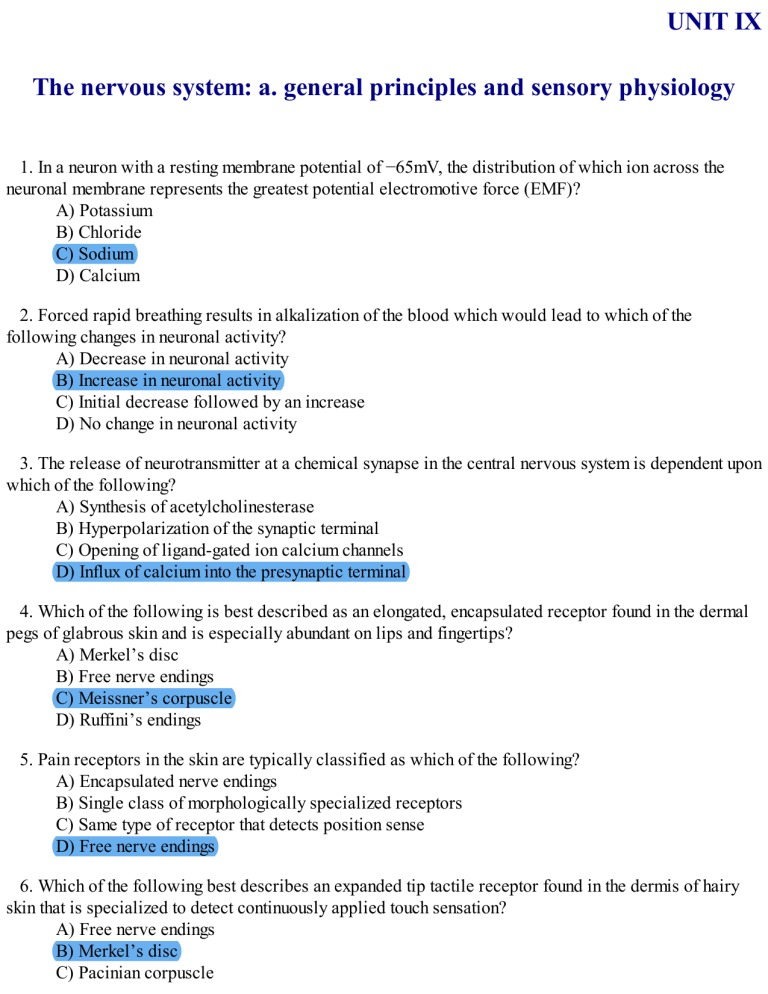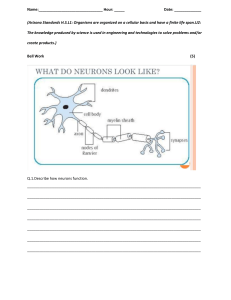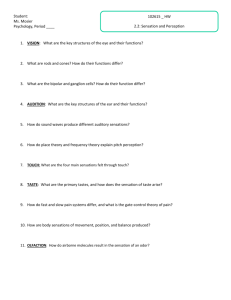
UNIT IX The nervous system: a. general principles and sensory physiology 1. In a neuron with a resting membrane potential of −65mV, the distribution of which ion across the neuronal membrane represents the greatest potential electromotive force (EMF)? A) Potassium B) Chloride C) Sodium D) Calcium 2. Forced rapid breathing results in alkalization of the blood which would lead to which of the following changes in neuronal activity? A) Decrease in neuronal activity B) Increase in neuronal activity C) Initial decrease followed by an increase D) No change in neuronal activity 3. The release of neurotransmitter at a chemical synapse in the central nervous system is dependent upon which of the following? A) Synthesis of acetylcholinesterase B) Hyperpolarization of the synaptic terminal C) Opening of ligand-gated ion calcium channels D) Influx of calcium into the presynaptic terminal 4. Which of the following is best described as an elongated, encapsulated receptor found in the dermal pegs of glabrous skin and is especially abundant on lips and fingertips? A) Merkel’s disc B) Free nerve endings C) Meissner’s corpuscle D) Ruffini’s endings 5. Pain receptors in the skin are typically classified as which of the following? A) Encapsulated nerve endings B) Single class of morphologically specialized receptors C) Same type of receptor that detects position sense D) Free nerve endings 6. Which of the following best describes an expanded tip tactile receptor found in the dermis of hairy skin that is specialized to detect continuously applied touch sensation? A) Free nerve endings B) Merkel’s disc C) Pacinian corpuscle D) Ruffini’s endings 7. Hypoventilation has which of the following effects on neuronal activity? A) Depresses neuronal activity B) Increases neuronal activity C) Increases synaptic delay D) Increases neurotransmitter release 8. Which of the following best describes the concept of specificity in sensory nerve fibers that transmit only one modality of sensation? A) Frequency coding principle B) Concept of specific nerve energy C) Singularity principle D) Labeled line principle 9. Which of the following is an encapsulated receptor found deep in the skin throughout the body as well as in fascial layers where they detect indentation of the skin (pressure) and movement across the surface (vibration)? A) Pacinian corpuscle B) Meissner’s corpuscle C) Free nerve endings D) Ruffini’s endings 10. Which of the following substances enhances the sensitivity of pain receptors but does not directly excite them? A) Bradykinin B) Serotonin C) Potassium ions D) Prostaglandins 11. Which of the following is an important functional parameter of pain receptors? A) Exhibit little or no adaptation B) Not affected by muscle tension C) Signal only flexion at joint capsules D) Can voluntarily be inhibited 12. The excitatory or inhibitory action of a neurotransmitter is determined by which of the following? A) Function of its postsynaptic receptor B) Molecular composition C) Shape of the synaptic vesicle in which it is contained D) Distance between the pre- and post-synaptic membranes 13. Which of the following statements concerning the transmission of pain signals into the central nervous system is correct? A) The “fast” pain fibers that conduct at about 6 to 30 m/sec are classified as type C fibers B) Type A-delta pain fibers are responsible for the localization of a pain stimulus C) Upon entering the spinal cord dorsal horn, the fast and slow pain fibers synapse with the same populations of neurons D) The paleospinothalamic tract is specialized to rapidly conduct pain signals to the thalamus 14. Which of the following is the system that transmits somatosensory information with the highest degree of temporal and spatial fidelity? A) Anterolateral system B) Dorsal column–medial lemniscal system C) Corticospinal system D) Spinocerebellar system 15. Which of the following pathways crosses in the ventral white commissure of the spinal cord within a few segments of entry and then courses to the thalamus contralateral to the side of the body from which the signal originated? A) Anterolateral system B) Dorsal column–medial lemniscal system C) Corticospinal system D) Spinocerebellar system 16. Which of the following statements concerning the mechanoreceptive receptor potential is/are true? A) Increase in stimulus energy results in an increase in receptor potential B) When receptor potential rises above a certain threshold action potentials will appear in the neuron attached the receptor C) Number of action potentials generated in the neuron attached to the receptor is proportional to receptor potential D) All of the above are correct 17. In chemical synapses that involve a so-called second messenger, typically a G-protein linked to the postsynaptic receptor is activated when neurotransmitter binds to that receptor. Which of the following represents an activity performed by the activated second messenger? A) Closure of a membrane channel for sodium or potassium B) Activation of cyclic AMP or cyclic GMP C) Inactivation of enzymes that initiate biochemical reactions in the postsynaptic neuron D) Inactivation of gene transcription in the postsynaptic neuron 18. Neurons located in which of the following areas release serotonin as their neurotransmitter? A) Periaqueductal gray area B) Interneurons of the spinal cord C) Periventricular area D) Nucleus raphe magnus 19. Which of the following systems conveys information concerning highly localized touch sensation and body position (proprioceptive) sensation? A) Anterolateral system B) Dorsal column–medial lemniscal system C) Corticospinal D) Spinocerebellar 20. Which of the following explains why individuals in severe pain have difficulty sleeping without sedative medication? A) The somatosensory cortical area for pain perception blocks the sleep-generating circuits B) Pain fibers entering the dorsal horn and the ascending pain pathways block the sleep-generating circuits C) Ascending pain pathways provide excitatory input to brainstem reticular formation areas that are involved in maintenance of the alert, waking state D) The neurotransmitters used in the slow pain pathway diffuse to neighboring cell groups and generally raise the excitability of the brain 21. The first-order (primary afferent) cell bodies of the dorsal column–medial lemniscal system are found in which of the following structures? A) Spinal cord dorsal horn B) Spinal cord ventral horn C) Dorsal root ganglia D) Nucleus cuneatus 22. Which of the following structures carries axons from the nucleus gracilis to the thalamus? A) Fasciculus gracilis B) Fasciculus lemniscus C) Lateral spinothalamic tract D) Medial lemniscus 23. Which of the following represents the basis for transduction of a sensory stimulus into nerve impulses? A) Change in the ion permeability of the receptor membrane B) Generation of an action potential C) Inactivation of a G-protein–mediated response D) Protein synthesis 24. Which of the following structures carries axons from neurons in the ventral posterolateral nucleus of the thalamus to the primary somatosensory cortex? A) Medial lemniscus B) External capsule C) Internal capsule D) Extreme capsule 25. Which of the following is characteristic of the events occurring at an excitatory synapse? A) There is a massive efflux of calcium from the presynaptic terminal B) Synaptic vesicles bind to the postsynaptic membrane C) Voltage-gated potassium channels are closed D) Ligand-gated channels are opened to allow sodium entry into the postsynaptic neuron 26. In a neuron with a resting membrane potential of −65mV, the distribution of which ion across the neuronal membrane represents the least potential electromotive force (EMF)? A) Potassium B) Chloride C) Sodium D) Calcium 27. Stimulation of which brain area can modulate the sensation of pain? A) Superior olivary complex B) Locus ceruleus C) Periaquaductal gray D) Amygdala 28. Which of the following body parts is represented superiorly and medially within the postcentral gyrus? A) Upper limb B) Lower limb C) Abdomen D) Genitalia 29. Which of the following is a group of neurons in the pain suppression pathway that utilizes enkephalin as a neurotransmitter? A) Postcentral gyrus B) Nucleus raphe magnus C) Periaqueductal gray D) Type AB sensory fibers 30. As the receptor potential rises higher above threshold, which of the following best characterizes the new frequency of action potentials? A) Decrease B) Increase C) Remain unchanged D) Increase only when the receptor potential increases to twice the level of threshold 31. Which of the following is a type of interneuron in this region that utilizes enkephalin to inhibit pain transmission? A) Nucleus raphe magnus B) Postcentral gyrus C) Dorsal horn of spinal cord D) Type C sensory fiber 32. The highest degree of pain localization comes from A) simultaneous stimulation of free nerve endings and tactile fibers B) stimulation of free nerve endings by bradykinin C) nerve fibers traveling to the thalamus by way of the paleospinothalamic tract D) stimulation of type A delta fibers 33. Inhibition of pain signals by tactile stimulation of a skin surface involves which of the following selections? A) Type A alpha fibers in peripheral nerves B) Type A beta fibers in peripheral nerves C) Type A delta fibers in peripheral nerves D) Type C fibers in peripheral nerves 34. Within the primary somatosensory cortex, the various parts of the contralateral body surface are represented in areas of varying size that reflect which of the following? A) The relative size of the body parts B) The density of the specialized peripheral receptors C) The size of the muscles in that body part D) The conduction velocity of the primary afferent fibers 35. The gray matter of the primary somatosensory cortex contains six layers of cells. Which of the following layers receives the bulk of incoming signals from the somatosensory nuclei of the thalamus? A) Layer I B) Layers II and III C) Layer III only D) Layer IV 36. Which of the following statements concerning the neuronal membrane at rest is correct? A) The extracellular sodium concentration is less than its intracellular concentration B) The concentration of chloride is greatest inside the cell C) If the resting potential is moved to a more negative value, the cell becomes more excitable D) The concentration gradient for potassium is such that it tends to move out of the cell 37. Which of the following is the basis for referred pain? A) Visceral pain signals and pain signals from the skin synapse with separate populations of neurons in the dorsal horn B) Visceral pain transmission and pain transmission from the skin is received by a common set of neurons in the thalamus C) Visceral pain signals are rarely of sufficient magnitude to exceed the threshold of activation of dorsal horn neurons D) Some visceral pain signals and pain signals from the skin provide convergent input to a common set of neurons in the dorsal horn 38. Post-tetanic facilitation is thought to be the result of A) opening voltage-gated sodium channels B) opening transmitter gated potassium channels C) a buildup of calcium in the presynaptic terminal D) electrotonic conduction 39. Pain from the stomach is referred to which area of the body? A) upper right shoulder area B) abdominal area above the umbilicus C) proximal area of the anterior and inner thigh D) abdominal area below the umbilicus 40. Which one of the following statements concerning visceral pain signals is correct? A) They are transmitted along sensory fibers that course mainly with sympathetic nerves in the abdomen and thorax B) They are not stimulated by ischemia in visceral organs C) They are transmitted only by the lightly myelinated type A delta sensory fibers D) They are typically well localized Questions 41–43 Each of the disorders in the following three questions is characterized either by the production of excessive pain (hyperalgesia) or the loss of pain sensation. 41. Which disorder is characterized by excessive pain in a skin dermatomal distribution resulting from a viral infection of a dorsal root ganglion? A) Tic douloureux B) Thalamic pain syndrome C) Brown-Séquard syndrome D) Herpes zoster 42. Which disorder involves a loss of pain sensation on one side of the body coupled with the loss of proprioception, precise tactile localization, and vibratory sensations on the contralateral side of the body? A) Herpes zoster B) Thalamic pain syndrome C) Lateral medullary syndrome D) Brown-Séquard syndrome 43. Which disorder is characterized by the loss of pain sensation throughout one entire side of the body and the opposite side of the face? A) Brown-Séquard syndrome B) Thalamic pain syndrome C) Herpes zoster D) Lateral medullary syndrome 44. Which of the following electrical events is characteristic of inhibitory synaptic interactions? A) A neurotransmitter agent that selectively opens ligand-gated chloride channels is the basis for an inhibitory postsynaptic potential B) Because the Nernst potential for chloride is about −70 mV, chloride ions tend to move out of the cell along its electrochemical gradient C) A neurotransmitter that selectively opens potassium channels will allow potassium to move into the cell D) An increase in the extracellular sodium concentration usually leads directly to an inhibitory postsynaptic potential 45. Which of the following somatosensory deficits is NOT typically seen following lesions that involve the postcentral gyrus? A) Inability to discretely localize touch sensation over the contralateral face and upper limb. B) Inability to judge the weight of easily recognizable objects C) Inability to accurately assess the texture of common objects by touching them with the fingers D) Inability to move the contralateral arm and leg 46. The ability to detect two points simultaneously applied to the skin is based on which of the following physiologic mechanisms? A) Presynaptic inhibition B) Lateral inhibition C) Medial inhibition D) Feed-forward inhibition 47. Stimulation by touching or pulling on which of the following structures is least likely to cause a painful sensation? A) The postcentral gyrus B) The dura overlying the postcentral gyrus C) Branches of the middle meningeal artery that lie superficial to the dura over the postcentral gyrus D) Branches of the middle cerebral artery that supply the postcentral gyrus 48. Vibratory sensation is dependent on the detection of rapidly changing, repetitive sensations. The high-frequency end of the repetitive stimulation scale is detected by which of the following? A) Merkel’s discs B) Meissner’s corpuscles C) Pacinian corpuscles D) Free nerve endings 49. Prolonged changes in neuronal activity are usually achieved through the activation of A) voltage-gated chloride channels B) transmitter-gated sodium channels C) G-protein–coupled channels D) voltage-gated potassium channels 50. Transmission of the electrical signal from the dendrites to the soma of a neuron occurs by which of the following? A) Short-circuit current flow B) An action potential mechanism C) Electrotonic conduction D) Capacitive discharge 51. Which one of the following statements concerning sensory neurons or their functional properties is true? A) All sensory fibers are unmyelinated B) In spatial summation, increasing signal strength is transmitted by using progressively greater numbers of sensory fibers C) Increased stimulus intensity is signaled by a progressive decrease in the receptor potential D) Continuous subthreshold stimulation of a pool of sensory neurons results in disfacilitation of those neurons E) Temporal summation involves signaling of increased stimulus strength by decreasing the frequency of action potentials in the sensory fibers 52. For a sensory nerve fiber that is connected to a Pacinian corpuscle located on palmar surface of the right hand, the synaptic connection with the subsequent neuron in the corresponding sensory pathway is located in A) the right dorsal column nucleus B) the left dorsal column nucleus C) the dorsal horn of the right side of the spinal cord D) the dorsal horn of the left side of the spinal cord 53. Migraine headaches typically begin with a prodromal symptom such as nausea, loss of vision, visual aura, or other sensory hallucinations. Which of the following is thought to be the cause of such prodromes? A) Increased blood flow to brain tissue in the visual or other sensory cortex B) A selective loss of GABA neurons in the various sensory areas of cortex C) Constipation D) Vasospasm leading to ischemia and a disruption of neuronal activity in the relevant sensory areas of cortex 54. Which statement concerning the generation of an action potential is correct? A) When the membrane potential in the soma/axon hillock dips below “threshold,” an action potential is initiated B) The action potential is initiated in synaptic boutons C) The least number of voltage-gated sodium channels in an axon is found near the node of Ranvier D) Once an action potential is initiated, it will always run its course to completion 55. Position sense, or more commonly proprioceptive sensation, involves muscle spindles and which of the following selections? A) Skin tactile receptors B) Deep receptors in joint capsules C) Both tactile and joint capsule receptors D) Pacinian corpuscles 56. The sensation of temperature is signaled mainly by warm and cold receptors whose sensory fibers travel in association with the sensory fibers carrying pain signals. Which of the following statements best characterizes the transmission of signals from warm receptors? A) Warm receptors are well characterized histologically B) Signals from warm receptors are mainly transmitted along slow-conducting type C sensory fibers C) Warm receptors are located well below the surface of the skin in the subcutaneous connective tissue D) There are 3 to 10 times more warm receptors than cold receptors in most areas of the body 57. Like other sensory systems, the somatosensory system has a descending component that functions to regulate the overall sensitivity of the system. Which of the following selections best describes the function of the corticofugal signals transmitted from the somatosensory cortex downward to the thalamus and dorsal column nuclei? A) Increase or decrease the perception of signal intensity B) Decrease the ability to detect body position sense C) Remove the thalamus from the processing of somatosensory signals D) Allow ascending information to bypass nucleus cuneatus and gracilis 58. Which of the following statements accurately describes a feature of temperature sensation by the nervous system? A) Cold receptors continue to be activated even if skin temperature is lowered well below its freezing point B) Both cold and warm receptors each have very specific, nonoverlapping ranges of temperature sensitivity C) Warm and cold receptors respond to both steady state temperatures and to changes in temperature D) Temperature receptor function is the result of ion conduction changes and not changes in their metabolic rate 59. Which of the following statements concerning synaptic transmission is correct? A) When a specific population of synaptic terminals is spread over the considerable surface of a neuron, their collective effects cannot spatially summate and lead to initiation of an action potential B) Even if the successive discharges of an excitatory synapse occur sufficiently close in time, they cannot temporally summate and initiate an action potential C) A neuron is “facilitated” when its membrane potential is moved in the less negative or depolarizing direction D) Even when rapidly stimulated by excitatory synaptic input for a prolonged period of time, neurons typically do not exhibit synaptic fatigue 60. Which of the following statements regarding the processing of sensory signals by a pool of neurons is correct? A) Convergence of input signals to individual neurons in the pool, each of which contributes to the same output channel, can lead to amplification of the signal B) Divergence of input signals to multiple neurons in the pool, each of which leads to a different output channel, can lead to diffusion of the signal C) The combination of multiple input signals from multiple sources onto a single neuron in the pool is an example of divergence D) The distribution of multiple input signals from a single source onto many neurons in the pool is an example of convergence Answers 1.C) The Nernst potential for sodium is +61 millivolts. A resting membrane potential of +61 millivolts would be required to prevent sodium from moving across the cell membrane. This value is much greater than either the Nernst potential for potassium (−86 millivolts) or that of chloride (−70 millivolts).





